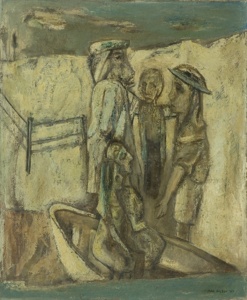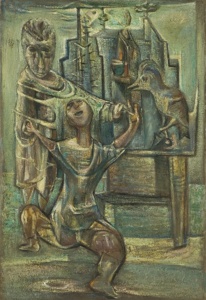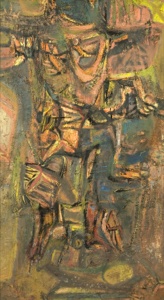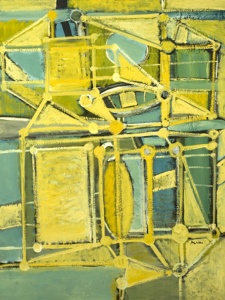The Roots of Abstraction
The road one chooses in Art, much like life, does not necessarily determine the final destination. A youth can start in yeshiva and paradoxically end up a surgeon, a public school student can still find their way into the rabbinate. And more to the point, a young artist can be well schooled in the skills of the academy, becoming proficient at draftsmanship, rendering reality and creating illusion, and still find his most potent expression in the complex mazes of abstraction. Such a young man was Ben Wilson and part of his long artistic journey can be seen at the Chassidic Art Institute in Crown Heights.
Ben Wilson was born in Philadelphia to Jewish immigrants from Kiev, Ukraine in 1910. He was, like so many of his generation, the first “real American” in his family and after graduating high school in 1929 he gravitated to commercial art school to learn a trade and make a life. With the onset of the Great Depression he began studying art at City College of New York at night and sporadically studied at the National Academy of Design. Later he also studied at the Educational Alliance Art School. All of his training was highly traditional, polishing the academic skills of realism. And yet this approach did not answer the young Wilson’s emotional or artistic needs. Instead his work gravitated to a brooding expressionism that would lead years later to abstraction. One of his teachers, the esteemed realist Leon Kroll, quipped that Wilson had “no reverence for nature.” For Wilson this was a supreme compliment and thereafter redoubled his “experimental work in abstraction” that was so dear to his heart.
The Depression was hard on everybody but for artists, already on the fringes of the employable, it was especially arduous. Therefore the WPA’s program of putting artists to work at decorating public buildings and producing their own art was deeply appreciated and according to Wilson was the beginning of “the renaissance of America in the arts.” Furthermore, the WPA was “responsible for the whole burgeoning of talent which finally resulted in the Abstract Expressionist school which effected the whole course of international culture.” For Ben Wilson and others similarly committed to non-representative images these times became the cauldron of radical culture and politics determined to transform a world deeply in trouble.

Wilson’s paintings in the 1930s and 1940s were dominated by moody expressionist imagery depicting strikes, protests, famine and despair. He was deeply affected by the social unrest at home and the war and conflict abroad, especially the Spanish Civil War, the Second World War and of course the Holocaust. During these years he later recounted that he was “in a state of perpetual depression, aggravated by everything….art and painting was a way of escaping the intolerable… by expressing it… a kind of cathartic endeavor.” Deportation (1943) is representative of Wilson’s approach at this time. Although there are five recognizable figures set in a landscape, everything is uncertain, everything held in a tension dominated by doubt and unease. Two women appear to be already seated in a boat while it is unclear whether the three individuals on the shore will join them, each lost in their own personal thoughts. The distortion of heads and facial features reflects the emotional disquiet and agitation within. Wilson’s awareness of the displacement and terrible suffering of the Jews in Europe clearly informed this image.
Success came early for Wilson with admission to the ACA Gallery in 1940 as one of the youngest artists ever to exhibit. The Gallery pioneered in showing American contemporary artists at a time when most of the art world would only consider work by Old Masters or European moderns. His accomplishments continued with a one-man show at the Gallery Neuf in 1946 showing “expressionist biblical parables” that was critically well received for its “sincere and vehement social protest.”
The depth of his Jewish consciousness is obvious in Guardian of the Torah (1940), a thickly painted depiction of three men pressed against and holding a Torah, guarding it from an unseen threat. Tallis and tefillin can be seen on them as they have just removed it from an ark directly to their right. Again the intensity of facial expression and distortion communicates the seriousness their sacred task.

Wilson was deeply sensitive to the world around him, almost incapable of ignoring the emotional currents of the time. Therefore after the war ended and the euphoria of liberation and rebuilding flooded the world’s consciousness, he painted Freedom Child (1949) as an ode to faith and rebirth. We see a child dancing, hopping for joy with its mother holding its hands and guiding the youth. An extraordinary bird appears on what might be a fantastic Torah ark behind them. The mood is surreally joyous and hopeful, a prayer for peace and life.
The 1950’s were a period of momentous change for Ben Wilson as he continued his search for a form more and more abstract, pursuing an intensely personal psychological and expressive style. The disquiet and anguish of his earlier years matured into the broadly philosophical and radical Abstract Expressionist approach to art. In a later interview he states that for him meaning in a painting arose in the “fertility of the very act of moving paint that stimulates the brain and evokes the image.” He began to make completely abstract images that “echo our basic nature… [namely that] we are not sequential, we are haphazard and sporadic, we are essentially disjunctive… always off target and subject to interruption.” Therefore he strived for the “aesthetic excitement of connecting things that are seemingly unrelated.” As America became enmeshed in the Cold War, nuclear proliferation and doomsday scenarios his abstractions sought to evoke a world off kilter, dangerous and yet yearning to be made whole, even if only momentarily, by an artist’s vision.

Burning Bush (1957) represents an example of Wilson’s leap to non-representative freedom. Nothing in the image is recognizable, rather the viewer must act as a passive / active participant in the flow of visual ideas. Fleshy pinks and reds are juxtaposed with brilliant yellows that find definition in a calligraphy of nervous black line. After experiencing the pure visual pleasure of color, form and line, the viewer must begin to navigate the connection, if any, between the visual and the textual biblical reference. That which we see here is an apparition, an image that exists for no apparent reason and yet something we want to appropriate, to define and somehow possess. Is this an echo of Moses’ burning bush, unintelligible and yet commanding, a mystery that soon possessed him?

For many viewers the initial response to abstraction is to figure out what it reminds us of in the concrete normative world. While a perfectly natural response this is frequently quite beside the point. Abstract paintings are created to operate as images with their own integrity, not as a referent to the real world. Their power resides in evoking our reactions, emotions and ideas based upon their own visual allure; the myriad pleasures and interest of pure paint, form, line and composition. And yet sometimes we can’t help ourselves. Yellow Ark (1975) evokes a very familiar structure, rectangles surmounted by triangular pediments and towers, all of which bespeaks some kind of building, some kind of construction that can surely serve as a container for the sacred. And yet upon closer examination each time a wall seems to stand it is pierced by a line or object that violates it, each building block is undermined and contradicted by another visual penetration. The inherent instability of the physical structures is left in anxious tension by Wilson’s vision.
Ben Wilson’s sixty-five years of making images took him many places along the aesthetic highway. His early training could not anticipate his deep devotion to abstraction and yet his background in academic drawing is certainly found in the fluid and expressive line that dominates many of his non-objective works. But perhaps the most constant element that runs through Wilson’s work is his sensitivity. Whether reacting to the growing catastrophe in Europe in the 1930’s or the lingering uncertainties of modern life in the late 20th century, Wilson was consistently a raw nerve, a bellwether in assessing the moral and emotional state of the world. His paintings were the battleground upon which the artist struggled with himself and a world profoundly unredeemed. His art was a way to reconcile this terrible contradiction. They are a visual tikun olam that never hesitated to face our troubled times brandishing the only thing an artist has to profess the hope that the world could be made better; his art.